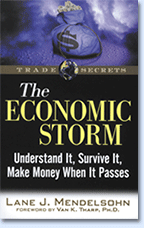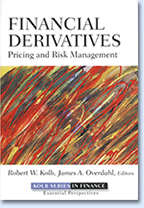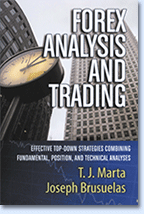Books For Traders
April 2010
- Buy And Hold Is Dead: How To Make Money And Control Risk In Any Market
- Chart Patterns
- The Economic Storm: Understand It, Survive It, Make Money When It Passes
- Financial Derivatives: Pricing And Risk Management
- Forex Analysis And Trading: Effective Top-Down Strategies Combining Fundamental, Position, And Technical Analyses
- The Quants: How A New Breed Of Math Whizzes Conquered Wall Street And Nearly Destroyed It
Return to Contents

![]() Buy And Hold Is Dead: How To Make Money And Control Risk In Any Market
Buy And Hold Is Dead: How To Make Money And Control Risk In Any Market
(303 pages, $34.95 hardcover, 2010, ISBN 978-0-470-45841-9) by Thomas H. Kee Jr., published by John Wiley & Sons.
For years now, financial gurus have told us to stay invested and we would make money in the long run. Unfortunately, that has not been true for some time. Over the past 10 years, all major averages are negative. Buy & hold investors have lost money, and this is something that is likely to continue. Investors must now take steps to protect their wealth. Learning how to make money in a volatile market is what this book is about. It offers strategies that work in both up and down markets, adjust themselves, and keeps you on the right side of the curve at all times. It reveals an approach to a market strategy that will allow you to take advantage of opportunities whenever they arise. The goal is to bring you to the comfort zone, and this book will show you how to get there.
Additional information: www.wiley.com
BACK TO LIST

![]() Chart Patterns
Chart Patterns
(192 pages, $29.95 hardcover, 2009, ISBN 978-1-57660-300-0) by Bruce M. Kamich, published by Bloomberg Press.
Chart patterns are among the earliest and still most popular tools of technical analysis. This guide shows the ins and outs of recognizing the specific patterns that are most useful for traders to know. Major tops and bottom, pennants, reversals, diamonds, and more are all covered. This guide is filled with practical advice for using patterns to trade more effectively. With an eye to the future of trading, it includes the roles of chaos theory and artificial intelligence.
Additional information: www.bloomberg.com/books
BACK TO LIST

![]() The Economic Storm: Understand It, Survive It, Make Money When It Passes
The Economic Storm: Understand It, Survive It, Make Money When It Passes
(146 pages, $19.95 softcover, 2009, ISBN 978-1-59280-380-6) by Lane J. Mendelsohn, with a foreword by Van K. Tharp, published by Marketplace Books.
This book cuts through the hype surrounding the current economic climate and drills down into the facts, revealing what traders can do to not only survive, but thrive in today’s challenging markets. With an examinations of past boom & bust cycles, it explains the events that came together to create the perfect storm of economic crisis that we are experiencing now. From the fear and greed on Wall Street to the bursting of the real estate bubble, readers will gain an understanding of the recession — so that they can set up and prepare for the recovery. It lays out guidelines for strategy development, potential investment opportunities, and specific investment tools that will help them manage this recession and the subsequent recovery.
Additional information: www.traderslibrary.com
BACK TO LIST

![]() Financial Derivatives: Pricing And Risk Management
Financial Derivatives: Pricing And Risk Management
(600 pages, $95 hardcover, 2010, ISBN 978-0-470-49910-8) by Robert W. Kolb and James A. Overdahl, eds., published by John Wiley & Sons.
Many investors point to the misuse of derivatives as one of the primary causes of the financial meltdown. Some financial derivatives are fairly simple, while others are quite complicated and require a lot of mathematical and statistical knowledge to understand. This huge text explores the contemporary world of financial derivatives. Starting with a presumption of only a little knowledge of finance, this collection of perspectives provides a comprehensive overview of the types of financial and the markets in which they trade. The book concludes with an examination of the many ways that derivatives can be used. They are valuable for managing risks, but they can also be used as very sophisticated speculation tools.
Additional information: www.wiley.com
BACK TO LIST

![]() Forex Analysis And Trading: Effective Top-Down Strategies Combining Fundamental, Position, And Technical Analyses
Forex Analysis And Trading: Effective Top-Down Strategies Combining Fundamental, Position, And Technical Analyses
(259 pages, $60 hardcover, 2009, ISBN 978-1-57600-339-0) by T.J. Marta and Joseph Brusuelas, published by Bloomberg Press.
Investors and traders have many different tools for analyzing the forex market. Here you will find the most widely used approaches to foreign exchange organized into one robust and powerful framework. Fundamental tools include real, effective exchange rates and trade and capital flows, and fair-value regressions. Position tool and technical tools are other organized groups. This book supplies an applicable framework for currency analysis that incorporates the theoretical but also shows the nuts & bolts considerations confronting currency traders and investors every day.
Additional information: www.bloomberg.com/books
BACK TO LIST

![]() The Quants: How A New Breed Of Math Whizzes Conquered Wall Street And Nearly Destroyed It
The Quants: How A New Breed Of Math Whizzes Conquered Wall Street And Nearly Destroyed It
(337 pages, $27 hardcover, 2010, ISBN 978-0-307-45337-2) by Scott Patterson, published by Crown, a division of Random House.
The proverbial “gut trader” has been supplanted by elite math geniuses — excryptographers, physicists, and game theorists — who’ve swapped old-style hunches for complicated algorithms and supercomputers. This book chronicles the story of the quants’ rise, their near-death experience, and their possible against-all-odds resurgence. The quants have become the masters of the Wall Street universe, though their role set off a chain of events that nearly destroyed the world’s financial markets. In the 1960s, an eccentric math professor-turned-blackjack-god named Ed Thorp saw vast reams of data that a clever person could analyze for patterns and profit from. This book profiles the incredible upward ascent of four of the quant elite’s most swashbuckling figures — Peter Muller, Ken Griffin, Cliff Asness, and Boaz Weinstein. These men created a digitized money-trading machine that could shift billions around the globe with the click of a mouse. The Quants examines the economic collapse on a panoramic level like no other book has.
Additional information: www.randomhouse.com
BACK TO LIST